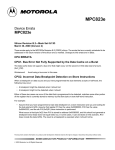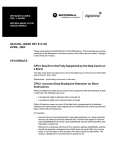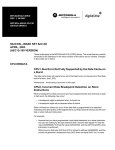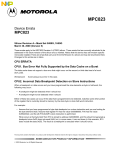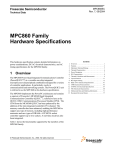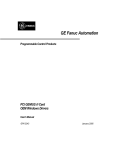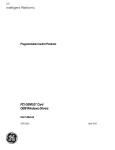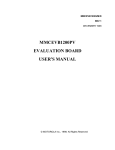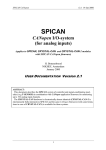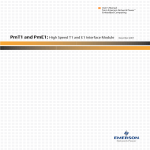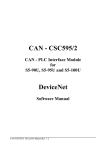Download 1.2 Dual-Port RAM
Transcript
5/99 MPC860P Supplement to the MPC860 PowerQUICC™ User’s Manual © Motorola Inc. 1999. All rights reserved. This document contains information on a new product under development. Motorola reserves the right to change or discontinue this product without notice. Information in this document is provided solely to enable system and software implementers to use PowerPC microprocessors. There are no express or implied copyright licenses granted hereunder to design or fabricate PowerPC integrated circuits or integrated circuits based on the information in this document. Motorola reserves the right to make changes without further notice to any products herein. Motorola makes no warranty, representation or guarantee regarding the suitability of its products for any particular purpose, nor does Motorola assume any liability arising out of the application or use of any product or circuit, and specifically disclaims any and all liability, including without limitation consequential or incidental damages. “Typical” parameters can and do vary in different applications. All operating parameters, including “Typicals” must be validated for each customer application by customer’s technical experts. Motorola does not convey any license under its patent rights nor the rights of others. Motorola products are not designed, intended, or authorized for use as components in systems intended for surgical implant into the body, or other applications intended to support or sustain life, or for any other application in which the failure of the Motorola product could create a situation where personal injury or death may occur. Should Buyer purchase or use Motorola products for any such unintended or unauthorized application, Buyer shall indemnify and hold Motorola and its officers, employees, subsidiaries, affiliates, and distributors harmless against all claims, costs, damages, and expenses, and reasonable attorney fees arising out of, directly or indirectly, any claim of personal injury or death associated with such unintended or unauthorized use, even if such claim alleges that Motorola was negligent regarding the design or manufacture of the part. Motorola and are registered trademarks of Motorola, Inc. Motorola, Inc. is an Equal Opportunity/Affirmative Action Employer. 10 10 This supplement to the MPC860 PowerQUICC™ User’s Manual highlights implementation-specific features of the MPC860 Plus (MPC860P) and how they differ from the MPC860. For features not described in this document, consult the MPC860 PowerQUICC™ User’s Manual, the MPC8xx ATM Supplement to the MPC860/MPC850 PowerQUICC ™ User’s Manual, the MPC860T Fast Ethernet Controller Supplement to the MPC860 PowerQUICC™ User’s Manual, and the QUICC ™ Multichannel Controller Supplement to the MC68360 & MPC860 User’s Manual. To locate any published errata or updates for this document, refer to the website at http://www.mot.com/netcomm. 1.1 Overview of the MPC860P The MPC860P is a pin-compatible enhanced version of the MPC860 PowerQUICC™ microprocessor that increases the instruction cache size from 4 to 16 Kbytes and the data cache from 4 to 8 Kbytes. Dual-port RAM is increased from 5 to 8 Kbytes, extending the flexibility and capabilities of the communications processor module (CPM). The MPC860P is also capable of system clock rates of 80 MHz and faster. As a superset of the MPC860SR and the MPC860T (revision D), the MPC860P supports ATM features including the UTOPIA interface, 10/100 base-T (Fast) Ethernet, and QMC microcode for multichannel HDLC support. Features of the MPC860P not implemented in the MPC860 are as follows: • • • • • Larger 8-Kbyte dual-port RAM, see Section 1.2, “Dual-Port RAM.” Improvements to cache implementation, see Section 1.3, “Instruction and Data Caches.” — 16-Kbyte, 4-way set-associative instruction cache — 8-Kbyte, 2-way set-associative data cache ATM support, see the MPC8xx ATM Supplement to the MPC860/MPC850 PowerQUICC ™ User’s Manual Fast Ethernet support, see the MPC860T Fast Ethernet Controller Supplement to the MPC860 PowerQUICC™ User’s Manual Multichannel HDLC support, see the QUICC ™ Multichannel Controller Supplement to the MC68360 & MPC860 User’s Manual MOTOROLA MPC860P Supplement -1 The shaded areas of the block diagram in Figure 1-1 show where the MPC860P differs from the MPC860. Instruction Bus Embedded PowerPC Processor Core 16-Kbyte Instruction Cache System Interface Unit (SIU) Unified Bus Memory Controller Instruction MMU 32-Entry ITLB Load/Store Bus Internal External Bus Interface Bus Interface Unit Unit 8-Kbyte Data Cache System Functions Data MMU 32-Entry DTLB Real-Time Clock PCMCIA-ATA Interface DMAs Parallel I/O FIFOs 4 Baud Rate Generators 10/100 Base-T Media Access Control 4 Timers Parallel Interface Port Timers and UTOPIA Interrupt 8-Kbyte Controllers Dual-Port RAM 32-Bit RISC Controller and Program ROM MAC 16 Virtual Serial and 2 Independent DMA Channels MII SCC1 SCC2 SCC3 SCC4 SMC1 SMC2 SPI I2C Time Slot Assigner Serial Interface Shaded blocks identify new features. Figure 1-1. MPC860P Block Diagram -2 MPC860P Supplement MOTOROLA 1.2 Dual-Port RAM This section describes how the MPC860P implements the 8-Kbyte dual-port RAM. Chapter 18, “Communications Processor,” of the MPC860 PowerQUICC™ User’s Manual has a complete description of the dual-port RAM. 1.2.1 RISC Microcode Development Support Control Register (RMDS) To accommodate the larger dual-port RAM, the MPC860P has an additional control register called the RISC microcode development support control register (RMDS). It is located near the RISC controller configuration register (RCCR) in the CP area of the internal memory map; see Table 1-1. (The RMDS area is reserved in the MPC860.) Table 1-1. RMDS Location in the CP Area of the Internal Memory Map Communications Processor (CP) Offset Name Size 0x9C0 CPCR—CP command register 16 bits 0x9C2–0x9C3 Reserved 2 bytes 0x9C4 RCCR—RISC controller configuration register 16 bits 0x9C6 Reserved 8 bits 0x9C7 RMDS—RISC microcode development support control register 8 bits . . . . . . . . . RMDS, shown in Figure 1-2, determines which regions of the dual-port RAM can contain executable microcode. RMDS is used with RCCR[ERAM] to determine the valid address space for executable microcode. Section 1.2.3, “System RAM and Microcode Packages,” describes the partitioning of the dual-port system RAM. Bit 0 Field ERAM4K 1 2 3 4 5 6 7 — Reset 0000_0000_0000_0000 R/W R/W Addr 0x9C7 Figure 1-2. RISC Microcode Development Support Control Register (RMDS) RMDS fields are described in Table 1-2. MOTOROLA MPC860P Supplement -3 Table 1-2. RMDS Field Descriptions Bits Name 0 ERAM4K 1–7 — Description Enable RAM microcode (at offset 4K) 0 Microcode may be executed only from the first 2 Kbytes of the dual-port RAM. 1 Microcode is also executed from the 2 Kbytes of the second half of the dual-port RAM with a 512-byte extension. Reserved, should be cleared. 1.2.2 Dual-Port RAM Map The CPM of the MPC860P has 8 Kbytes of static RAM configured as dual-port memory, shown in Figure 1-3. Dual-Port RAM 1,024 Bytes BD/Buffers/Microcode 1,024 Bytes BD/Buffers/Microcode U-Bus Addr CP Microcode Instr Addr 512 Bytes BD/Buffers/Microcode Address Selectors CP Data Addr 1,024 Bytes BD/Buffers/Microcode Data Selectors CP Microcode Instr U-Bus Data CP Data 1,024 Bytes BD/Buffers/Microcode 512 Bytes BD/Buffers/Microcode 2,048 Bytes BD/Buffers U-Bus Addr Address Selectors CP Data Addr 1,024 Bytes Parameter RAM Data Selectors Shaded area is system RAM. Note that in this figure, the area is not contiguous memory. For an accurate representation of the physical implementation, see Figure 1-4. Figure 1-3. Dual-Port RAM Block Diagram The dual-port RAM consists of 7 Kbytes of system RAM (see Section 1.2.3, “System RAM and Microcode Packages”) and 1 Kbyte of parameter RAM. The controller and sub-block parameters of the parameter RAM and the optional microcode packages in system RAM use fixed addresses. The buffer descriptors, buffers, and scratch pad area, however, can be located in any unused dual-port RAM area. See Figure 1-4. -4 MPC860P Supplement MOTOROLA 0 Kbyte– ERAM = 01– ERAM = 10– BD/Data/Microcode IMMR + 0x2000 BD/Data/Microcode IMMR + 0x2200 ERAM = 11– 1 Kbyte– IMMR + 0x2400 BD/Data/Microcode 2 Kbyte– IMMR + 0x2800 BD/Data 3 Kbyte– ERAM = 11– ERAM = 01, 10– ERAM4K = 1– BD/Data/Microcode IMMR + 0x2E00 IMMR + 0x2F00 IMMR + 0x3000 4 Kbyte– 5 Kbyte– BD/Data/Microcode 6 Kbyte– BD/Data IMMR + 0x3800 BD/Data/Microcode IMMR + 0x3A00 ERAM4K = 1– 7 Kbyte– Parameters for the Peripheral Controllers Parameter RAM– IMMR + 0x3C00 8 Kbyte– RCCR[ERAM] governs memory allocation for microcode in dark-shaded areas. RMDS[ERAM4K] governs memory allocation for microcode in light-shaded areas. Figure 1-4. Dual-Port RAM Memory Map 1.2.3 System RAM and Microcode Packages When optional Motorola-supplied RAM microcode packages are activated, certain portions of the 7-Kbyte system RAM are no longer available. (The 1-Kbyte parameter RAM is not affected.) Depending on the memory requirements of the microcode package, some or all of the shaded areas of Figure 1-4 become locked. Reads to locked areas return all ones. The unshaded 2-Kbyte (non-contiguous) area of system RAM is always available to the user. The enable-RAM-microcode field of the RISC configuration register, RCCR[ERAM], selects the three possible configurations for microcode area sizes—first 512-byte block, first two 512-byte blocks, or first four 512-byte blocks. When just the first and/or second 512-byte blocks are used for microcode, an additional 256-byte extension of system RAM is also locked. When all four 512-byte blocks are used for microcode, an additional 512-byte extension of system RAM is locked. See the dark-shaded areas of Figure 1-4. In addition to RCCR[ERAM], RMDS[ERAM4K] (enable RAM microcode at offset 4K) affects the system RAM memory configuration for microcode packages. Setting MOTOROLA MPC860P Supplement -5 RMDS[ERAM4K] locks a 2-Kbyte block and a 512-byte extension (the light-shaded areas of Figure 1-4) for microcode execution. 1.3 Instruction and Data Caches This section describes the MPC860P differences in the organization of the on-chip instruction and data caches, and in the bit fields of the cache control registers. See the cache chapter of the MPC860 PowerQUICC™ User’s Manual for a complete description. The MPC860P cache implementation has the following enhancements: • • The instruction cache is 16 Kbytes. It has 256 sets and is four-way set associative. The data cache is 8 Kbytes. It has 256 sets and is two-way set associative. 1.3.1 Instruction Cache Organization The MPC860P instruction cache is organized as 256 sets of four blocks, as shown in Figure 1-5. Each block consists of 16 bytes, a single state bit, a lock bit, and an address tag. -6 MPC860P Supplement MOTOROLA 0 19 20 27 28 29 Instruction effective address 2 20 Word select 8 20 20 20 .. .. L R U A r r a y Valid bit Lock bit ... .. .. 254 255 Way3 tag 0 1 w0 w1 w2 w3 .. .. Valid bit Lock bit ... .. .. . . 254 . . 255 set254 254 set255 255 Way2 tag 0 1 w0 w1 w2 w3 .. .. Valid bit Lock bit ... w0 w1 w2 w3 .. .. Valid bit Lock bit ... set0 set1 Way1 tag 0 1 w0 w1 w2 w3 Way0 tag 0 1 .. .. 254 255 20 MMU 128 COMP 128 COMP hit0 128 COMP hit1 128 COMP hit2 hit3 Bidirectional multiplexer 4 -> 1 128 HIT To block buffer/ From burst buffer Figure 1-5. Instruction Cache Organization Each instruction cache block contains four contiguous words from memory that are loaded from a four-word boundary; that is, bits A[28–31] of the logical (effective) addresses are zero. As a result, cache blocks are aligned with page boundaries. Also, address bits A[20–27] provide the index to select a set, and bits A[28–29] select a word within a block. The tags consist of the high-order physical address bits PA[0–19]. Address translation occurs in parallel with set selection (from A[20–27]). MOTOROLA MPC860P Supplement -7 1.3.2 Data Cache Organization The data cache is organized as 256 sets of two blocks as shown in Figure 1-6. Each block consists of 16 bytes, two state bits, a lock bit, and an address tag. 0 19 20 27 28 31 Data effective address 4 20 Byte select 8 way0 set254 tag254 set255 tag255 tag0 tag1 w0 w1 w2 w3 . . w0 w1 w2 w3 . . .. .. tag254 tag255 20 ... ... ... w0 w1 w2 w3 w0 w1 w2 w3 Dirty bit Valid bit Lock bit ... L R U .. .. A r r a y ... ... Dirty bit Valid bit Lock bit ... tag0 tag1 ... set0 set1 way1 w0 w1 w2 w3 . . w0 w1 w2 w3 . . w0 w1 w2 w3 w0 w1 w2 w3 20 MMU 128 128 COMP COMP hit1 hit0 Bidirectional multiplexer 2 -> 1 128 HIT To/from block buffer To/from burst buffer Figure 1-6. Data Cache Organization Each cache block contains four contiguous words from memory that are loaded from a four-word boundary; that is, bits A[28–31] of the logical (effective) addresses are zero. As a result, cache blocks are aligned with page boundaries. Note that address bits A[20–27] -8 MPC860P Supplement MOTOROLA provide the index to select a cache set. Bits A[28–31] select a byte within a block. The tags consist of the high-order physical address bits PA[0–19]. Address translation occurs in parallel with set selection (from A[20–27]). 1.3.3 Cache Control Registers The MPC860P bit fields and commands of the cache control and status registers (IC_CST and DC_CST) are unchanged from the MPC860; however, the bit fields of the cache address registers (IC_ADR and DC_ADR) and the cache data port registers (IC_DAT and DC_DAT) reflect the changed organization of the caches. 1.3.3.1 Reading Data and Tags in the Instruction Cache The MPC860P supports reading the data, tags, and the state and lock bits stored in the instruction cache. The instruction cache read command, issued by reading the IC_DAT register, uses the IC_ADR register to qualify what is to be read. Table 1-3 describes the fields of the IC_ADR register during an instruction cache read command. Table 1-3. IC_ADR Fields for Cache Read Commands 0–16 Reserved 17 0 Tag 1 Data 18–19 00 Way 0 01 Way 1 10 Way 2 11 Way 3 20–27 28–29 30–31 Set select (0–255) Word select (used only for data array) Reserved To read the data or tags stored in the instruction cache, do the following: 1. Write the address of the data or tag to be read to the IC_ADR according to the format shown in Table 1-3. Note that it is also possible to read this register for debugging purposes. 2. Read the IC_DAT register. For data array (IC_ADR[17] = 1) read commands, the word selected by IC_ADR[28–29] is placed in the target general-purpose register. For tag array (IC_ADR[17] = 0) read commands, the tag and state information is placed in the target general-purpose register. Table 1-4 provides the format of the IC_DAT register for a tag read. Table 1-4. IC_DAT Format for a Tag Read (IC_ADR[17] = 0) 0–19 20–21 22 Tag value Reserved 0 Invalid 1 Valid MOTOROLA 23 0 Unlocked 1 Locked 24–29 30–31 LRU code: If bit 29 is set, way3 is more recent than way2. If bit 28 is set, way3 is more recent than way1. If bit 27 is set, way3 is more recent than way0. If bit 26 is set, way2 is more recent than way1. If bit 25 is set, way2 is more recent than way0. If bit 24 is set, way1 is more recent than way0. Reserved MPC860P Supplement -9 1.3.3.2 Reading Data Cache Tags and Copyback Buffer The MPC860P supports reading the tags, the state bits and the lock bits stored in the data cache as well as the last copyback address, and data words in the copyback buffer. The data cache read command, issued by reading DC_DAT, uses the DC_ADR register to qualify what is to be read. Table 1-5 describes the fields of the DC_ADR register during a data cache read command. Table 1-5. DC_ADR Fields for Cache Read Commands 0–17 Reserved 18 0 Tags 19 0 Way 0 1 Way 1 1 Copyback buffer Reserved 20–27 28–31 Set select (0–255) Reserved Copyback buffer address/ data-word select To read the copyback buffer data or the tags stored in the data cache, do the following: 1. Write the address of the copyback buffer or tag to be read to the DC_ADR according to the format shown in Table 1-5. Note that it is also possible to read this register for debugging purposes. 2. Read the DC_DAT register. Note that writing to the DC_DAT register is illegal. A write to DC_DAT results in an undefined data cache state. For tag array (DC_ADR[18] = 0) read commands, the tag and state information is placed in the target general-purpose register. Table 1-6 provides the format of the DC_DAT register for a tag read. Table 1-6. DC_DAT Format for a Tag Read (DC_ADR[18] = 0) 0–19 20–21 Tag value Reserved 22 0 Invalid 1 Valid 23 0 Unlocked 1 Locked 24 25 LRU bit of this 0 Unmodified set 1 Modified 26–31 Reserved The last copyback address or data buffer can be read by using the copyback buffer read command (DC_ADR[18] = 1). The copyback buffer select field (DC_ADR[20–27]), shown in Table 1-7, determines which word of the cache block in the copyback buffer is read. -10 MPC860P Supplement MOTOROLA Table 1-7. Copyback Buffer Select Field (DC_ADR[20–27]) Encoding DC_ADR[20–27] Buffer Selected 0x00 Copyback buffer data word 0 0x01 Copyback buffer data word 1 0x02 Copyback buffer data word 2 0x03 Copyback buffer data word 3 0x04 Copyback address 1.3.4 Instruction and Data Cache Operations The MPC860P instruction and data cache operations are unchanged from the MPC860. However, be aware that bits 20–27 of the address provide the index to select a set (0–255) within the cache arrays, and that the tags from each way of the set are compared against bits 0–19 of the address; see Figure 1-5 and Figure 1-6. Note also that when determining a cache hit or miss, the instruction cache of the MPC860P has four possible ways for each set. MOTOROLA MPC860P Supplement -11 -12 MPC860P Supplement MOTOROLA














